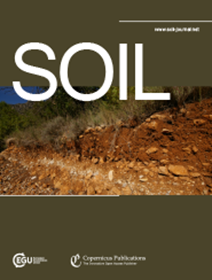深入挖掘:评估多样性保护性农业实践中的土壤质量
IF 4.3
2区 农林科学
Q1 SOIL SCIENCE
引用次数: 0
摘要
摘要。保护性农业(CA)旨在通过三个主要原则来提高土壤质量:尽量减少土壤的机械干扰,最大限度地增加土壤有机覆盖度,使作物品种多样化。然而,在CA内,实践的多样性使得对土壤质量的影响难以预测。在本研究中,对比利时瓦隆地区四种不同CA类型的CA田进行了土壤质量评价。考察了土壤结构稳定性、土壤有机碳与粘土比(SOC: clay)和土壤活性碳分数(POXC) 3个土壤质量指标。结果显示ca类型之间存在显著差异。在作物序列中,以大量临时草地和粗放型作物(如谷物、豆绒、油菜、亚麻)为特征的ca型土壤结构稳定性和有机碳:粘比最高。相比之下,严格实行不倒耕和频繁种植耕作密集型作物(如甜菜、菊苣、土豆、胡萝卜)的ca型在三项指标上得分最低。作物序列中的临时草地是改善土壤质量的最重要因素。这些发现强调,在评估CA系统的农艺和环境绩效时,需要考虑CA类型的多样性,其响应取决于当地土壤和气候条件、种植的作物以及实施的具体实践组合。本文章由计算机程序翻译,如有差异,请以英文原文为准。
Digging Deeper: Assessing Soil Quality in a Diversity of Conservation Agriculture Practices
Abstract. Conservation Agriculture (CA) aims to enhance soil quality through three main principles: minimizing mechanical soil disturbance, maximizing soil organic cover, and diversifying crop species. However, the diversity of practices within CA makes the effect on soil quality hardly predictable. In this study, an evaluation of soil quality in CA fields across Wallonia (Belgium) was conducted for four distinct CA-types. Three soil quality indicators were examined: the soil structural stability, the soil organic carbon:clay ratio (SOC:Clay), and the labile carbon fraction (POXC). Results revealed significant variations among CA-types. The CA-type characterized by substantial temporary grassland and tillage-extensive crops (e.g., cereals, meslin, rape, flax) in the crop sequence had the highest soil structural stability and SOC:Clay ratio. In contrast, the CA-type characterized by strict non-inversion tillage practices and frequent tillage-intensive crops (e.g., sugar beet, chicory, potatoes, carrots) had the lowest scores for the three indicators. Temporary grassland in the crop sequence appeared as the most influential factor improving soil quality. These findings highlight the need to consider the diversity of CA-type when evaluating the agronomic and environmental performance of CA systems, whose response depends on local soil and climatic conditions, the crops cultivated, and the specific combination of practices implemented.
求助全文
通过发布文献求助,成功后即可免费获取论文全文。
去求助
来源期刊

Soil
Agricultural and Biological Sciences-Soil Science
CiteScore
10.80
自引率
2.90%
发文量
44
审稿时长
30 weeks
期刊介绍:
SOIL is an international scientific journal dedicated to the publication and discussion of high-quality research in the field of soil system sciences.
SOIL is at the interface between the atmosphere, lithosphere, hydrosphere, and biosphere. SOIL publishes scientific research that contributes to understanding the soil system and its interaction with humans and the entire Earth system. The scope of the journal includes all topics that fall within the study of soil science as a discipline, with an emphasis on studies that integrate soil science with other sciences (hydrology, agronomy, socio-economics, health sciences, atmospheric sciences, etc.).
 求助内容:
求助内容: 应助结果提醒方式:
应助结果提醒方式:


